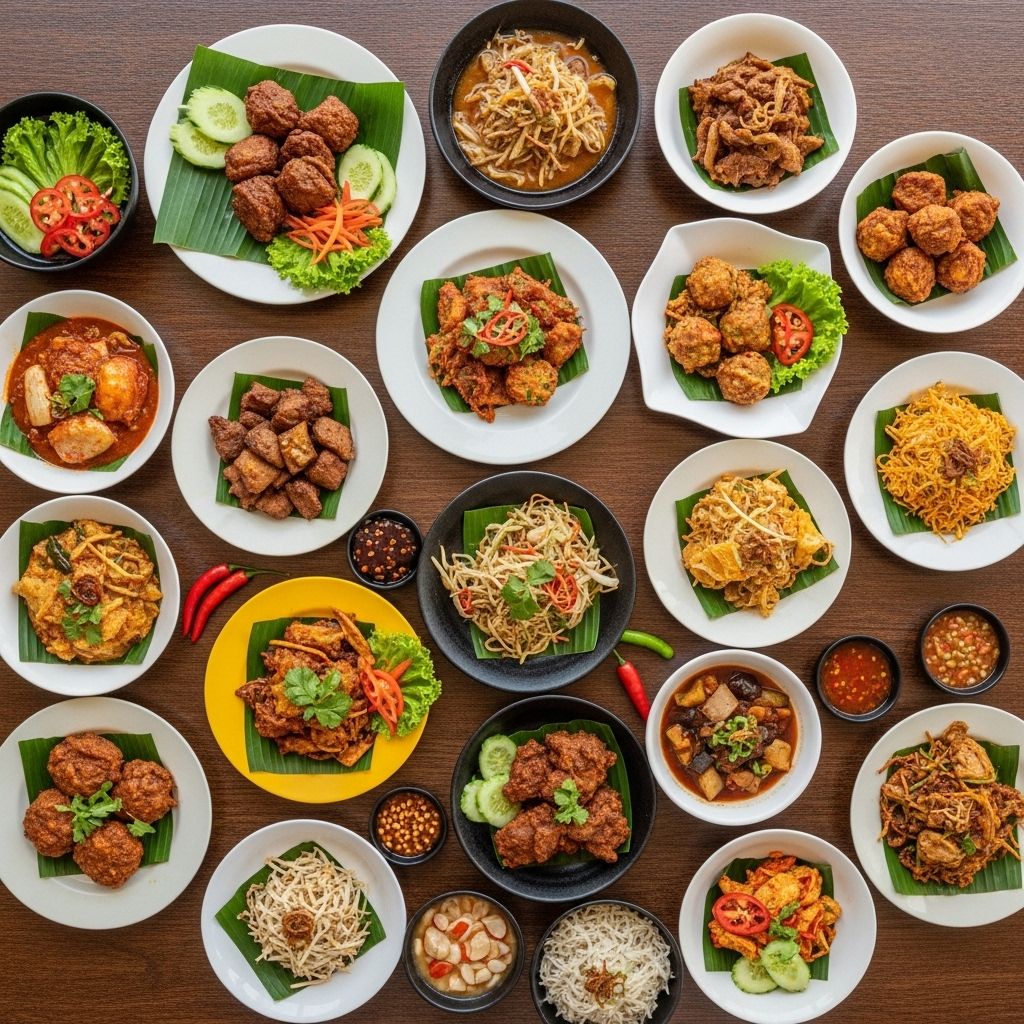16 Essential Malaysian Recipes: A Flavorful Introduction to Malaysian Cuisine
A concise guide to Malaysia’s spice-forward dishes that honor its rich culinary heritage.

Malaysia’s culinary heritage is a captivating symphony of ethnic influences, centuries-old traditions, and a shared love of bold, harmonious flavors. This Southeast Asian nation unites the culinary legacies of the Malay, Chinese, and Indian communities, alongside Indigenous, Eurasian, and neighboring Southeast Asian traditions, yielding an excitable array of dishes that grace homes, hawker stalls, and festive tables alike. This article presents 16 essential Malaysian recipes—a practical primer for anyone eager to discover the treasures of Malaysia’s kitchen.
Cultural Tapestry of Malaysian Cuisine
Malaysian cuisine stands at the crossroads of Asia, and every bite tells a story of trade, migration, and innovation. Its flavors are shaped by the following distinct yet often overlapping influences:
- Malay: Relying on fresh herbs, lemongrass, galangal, coconut milk, and complex spice pastes known as rempah.
- Chinese: Wok-fried noodles, quick stir-fries, and clear soups, as well as street meats and noodle dishes brought by Southern Chinese immigrants.
- Indian: Robust curries, flatbreads, and fragrant rice dishes, especially prominent in Peninsular Malaysia’s south and major cities.
- Nyonya (Peranakan): A fusion cuisine developed by the descendants of Chinese settlers who married into Malay communities, resulting in vibrant dishes blending local and Chinese influences.
This diversity is reflected in everyday meals and the country’s legendary food markets. The following recipes represent some of Malaysia’s most iconic and accessible dishes, each with its own cultural heritage and story.
1. Nasi Lemak: Malaysia’s National Dish
Nasi lemak is widely regarded as Malaysia’s unofficial national dish. Its heart is coconut rice, fragrant with pandan leaves. It comes with a host of classic accompaniments:
- Spicy-sweet sambal (chili paste)
- Crispy fried ikan bilis (anchovies)
- Roasted peanuts
- Cool cucumber slices
- Hard-boiled or fried egg
- Optional: Fried chicken, squid, or rendang beef
The brilliance of nasi lemak is not just in its rich coconut-scented rice, but in the interplay of spicy, creamy, salty, and fresh. Traditionally eaten for breakfast, it also stars as lunch, dinner, or a late-night snack throughout Malaysia.
2. Char Kway Teow
Char kway teow is the ultimate Penang street food: silky rice noodles stir-fried in a searing hot wok with garlic, eggs, Chinese sausage, bean sprouts, and prawns or cockles. Chives and a kiss of soy sauce round out this smoky, umami-packed classic. The dish’s signature wok hei—a charred, slightly smoky note—is the mark of a true master.
3. Roti Canai (Crispy Flaky Flatbread)
This Indian-Muslim creation is an indispensable part of Malaysia’s breakfast scene. Roti canai features soft, stretchy, and ultra-flaky bread cooked on a griddle until golden and crisp. Usually accompanied by a small bowl of aromatic dhal (lentil curry) or sometimes served with chicken or fish curry. The hands-on preparation—stretch, fold, and slam the dough—gives this bread its hallmark layers and chew.
4. Hainanese Chicken Rice
This beloved Malaysian adaptation of a southern Chinese classic features poached chicken served atop ginger-scented rice, with a lively chili-garlic sauce and sometimes dark soy and cucumber. The rice is often as cherished as the chicken: it’s stir-fried in chicken fat and cooked in rich chicken stock with ginger and pandan leaves.
5. Nasi Goreng (Malaysian Fried Rice)
Malaysia’s take on fried rice—nasi goreng—delivers bold flavors by incorporating sambal, soy, shallots, garlic, and shrimp paste, giving the rice a reddish-golden hue and a satisfyingly umami depth. Proteins can vary: shrimp, chicken, or even leftover rendang make frequent appearances. Fried egg crowns the dish for an added hit of richness.
6. Laksa (Nyonya Laksa / Laksa Lemak / Penang Assam Laksa)
Laksa is both a dish and a family of noodle soups celebrated for their explosive flavors. There are two primary regional types:
- Curry laksa or laksa lemak: Rich, coconut milk-based broth, usually with rice noodles, tofu puffs, shrimp, and cockles, garnished with Vietnamese mint and sambal.
- Penang assam laksa: A tamarind-soured fish broth, spicy and tangy, with thick rice noodles, mackerel or sardine, mint, cucumber, onion, and a swirl of hei ko (shrimp paste).
Both varieties are icons of their respective regions and showcase the multicultural backbone of Malaysian cooking.
7. Satay (Grilled Skewered Meats)
Satay—seasoned skewers of beef, chicken, or lamb—are grilled to smoky perfection over hot coals and served with a thick, slightly sweet peanut sauce. Accompaniments include compressed rice cakes (nasi impit), raw onion, and cooling cucumber. The marinades are sometimes laced with turmeric, coriander, and lemongrass.
8. Beef Rendang (Slow-Cooked Dry Curry)
This regal dish, originating in the Minangkabau community and also widespread in Indonesia, is a hallmark of festive occasions. Beef rendang features beef simmered for hours in a rich aromatic paste of spices, coconut milk, lemongrass, and toasted coconut, producing intensely flavored and tender meat coated in a dry, spiced crust.
9. Asam Pedas (Spicy Tamarind Fish Stew)
Asam pedas is a fiery, tangy, and aromatic fish stew—its name means “sour spicy”—featuring fresh fish (mackerel or stingray), okra, and tomatoes in a broth scented with tamarind, chili, and regional aromatic herbs. It showcases the Malay love for layered, dynamic flavors.
10. Ikan Bakar (Grilled Fish with Sambal)
This crowd-pleasing dish features whole fish—commonly stingray, snapper, or mackerel—marinated with turmeric, chili, and aromatics. The fish is grilled over charcoal, wrapped in banana leaves, and served with dollops of spicy sambal. The smoky notes and piquant sauce are quintessentially Malaysian.
11. Ayam Goreng (Malaysian Fried Chicken)
Malaysia’s answer to fried chicken is acclaimed for its deeply seasoned, crisp, and juicy result. Ayam goreng is marinated in a blend of turmeric, coriander, garlic, and sometimes coconut milk before being fried to golden perfection. Often eaten as a snack or with nasi lemak, this dish is irresistible comfort food.
12. Masak Lemak (Vegetables or Meat Cooked in Coconut Milk)
Masak lemak is a beloved cooking style throughout Malaysia, as foundational as it is versatile. Vegetables, seafood, or meat are simmered in a gentle, aromatic coconut milk sauce, enlivened with turmeric, lemongrass, and birds-eye chili. Dishes range from masak lemak cili api (spicy) to milder versions, and feature ingredients like pumpkin, long beans, or prawns. [Masak lemak is one of Malaysia’s most popular cooking styles and it’s incredibly easy to incorporate into your every day.]
13. Teh Tarik (Malaysian Pulled Tea)
This frothy, sweet milk tea—Malaysia’s unofficial national drink—gets its aerated texture and creamy head from the theatrical process of “pulling”: streaming the tea from mug to mug. Teh tarik combines strong black tea with condensed and evaporated milk, making a rich, soothing beverage that’s loved across generations.
14. Cendol (Shaved Ice Dessert with Pandan Noodles)
This classic Malaysian dessert is the perfect relief on a tropical day. Cendol features shaved ice topped with tender green pandan jelly noodles, coconut milk, and palm sugar syrup (gula Melaka). Sweet red beans and glutinous rice add texture for a refreshing, indulgent treat.
15. Pisang Goreng (Fried Bananas)
Street vendors countrywide serve this universally loved snack: bananas are battered and deep-fried until the coating turns shatteringly crisp, creating a moreish contrast with the warm, soft fruit inside. Cooks sometimes use plantains or other starchy, cooking varieties for extra crunch.
16. Kaya Toast (Toasted Bread with Coconut Jam)
This simple yet addictive breakfast hails from Malaysian kopitiams (coffee shops). Slices of bread are toasted over charcoal or in a toaster, slathered with kaya (a creamy coconut-egg jam scented with pandan) and butter. Kaya toast is often served with soft-boiled eggs and a robust cup of local coffee for an unbeatable start to the day.
Table: Malaysian Dishes and Their Main Components
| Dish | Main Ingredients | Key Flavors | Cultural Roots |
|---|---|---|---|
| Nasi Lemak | Coconut rice, anchovies, peanuts, egg, sambal | Creamy, spicy, salty | Malay |
| Char Kway Teow | Rice noodles, shrimp, soy sauce, Chinese sausage | Smoky, savory | Chinese-Malaysian |
| Roti Canai | Wheat flour, ghee, curry | Buttery, flaky, spicy | Indian-Muslim |
| Beef Rendang | Beef, coconut, lemongrass, chili | Rich, aromatic, spicy | Malay-Minangkabau |
| Cendol | Pandan noodles, coconut milk, palm sugar | Sweet, creamy | Nyonya/Malay |
Tips for Cooking Malaysian Food at Home
- Stock up on Southeast Asian staples: Aromatics like lemongrass, galangal, turmeric, and kaffir lime leaves are fundamental, as are coconut milk, dried shrimp, and spice blends.
- Don’t skip the sambal: This spicy chili paste is both a condiment and a flavoring agent in many dishes.
- Practice multi-component meals: Many Malaysian dishes are built from several elements—rice, main protein, condiments—served together for a harmony of flavors and textures.
- Use bold seasoning: Malaysian recipes seldom shy from spice; taste, adjust, and let the flavors sing.
Frequently Asked Questions (FAQs)
Q: Can Malaysian recipes be made vegetarian or vegan?
A: Yes. Many core ingredients are plant-based, such as coconut milk, tofu, tempeh, and root vegetables. Simply substitute proteins with plant alternatives and use vegetarian-friendly sauces.
Q: Are Malaysian dishes always spicy?
A: While heat is prevalent, spice levels can be adjusted. Dishes like nasi lemak or laksa may use sambal on the side, so diners control the level of heat.
Q: What’s the best way to find Malaysian ingredients outside Malaysia?
A: Seek out Southeast Asian or pan-Asian groceries, many of which stock essentials like pandan, curry leaves, and belacan (fermented shrimp paste). Some ingredients are also available online.
Q: Which Malaysian recipe is easiest for beginners?
A: Roti canai and nasi goreng are two of the most accessible dishes, as they use basic techniques and widely available ingredients. Kaya toast and teh tarik are also beginner friendly.
Further Reading and Exploration
To delve deeper into Malaysian cooking, consider learning about its regional variations—Penang’s vibrant hawker culture, the Indian-Muslim cuisine in Kuala Lumpur, or the traditional foods of Borneo. Beyond these 16 recipes lies a universe of flavors, from regional salads to seasonal sweets. Malaysian cuisine is not just a collection of recipes, but an invitation to experience the country’s communal spirit, creativity, and pride—one delicious dish at a time.
Read full bio of Srija Burman












